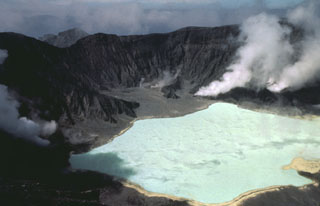Report on El Chichon (Mexico) — October 1983
Scientific Event Alert Network Bulletin, vol. 8, no. 10 (October 1983)
Managing Editor: Lindsay McClelland.
El Chichon (Mexico) Fumarole and crater lake temperatures decline
Please cite this report as:
Global Volcanism Program, 1983. Report on El Chichon (Mexico) (McClelland, L., ed.). Scientific Event Alert Network Bulletin, 8:10. Smithsonian Institution. https://doi.org/10.5479/si.GVP.SEAN198310-341120
El Chichon
Mexico
17.3602°N, 93.2297°W; summit elev. 1150 m
All times are local (unless otherwise noted)
A team of scientists descended into the crater during the week of 16 October. They found no new tephra or other signs of recent eruptive activity. The temperature of the crater lake had decreased to 42°C from 52-58°C during the previous descent in late January. The lake had receded substantially between the late January visit and observations from the crater rim 21 April but lake level was not appreciably lower in October. Average fumarole temperatures had dropped from 116°C in January to 99° in October. In the talus rampart just above the crater floor, a small low-pressure fumarole that had registered a temperature of 446°C in January was no longer active in October. No other notable changes in fumarole position were noted. No significant seismic activity has been recorded at El Chichón in recent months although some tectonic seismicity has occurred SE of the volcano.
Further Reference. Casadevall, T., de la Cruz-Reyna, S., Rose, W.I. Jr., Bagley, S., Finnegan, D.L., and Zoller, W.H., 1984, Crater lake and post-eruption hydrothermal activity, El Chichón Volcano, México: JVGR, v. 23, p. 163-191.
Geological Summary. El Chichón is a small trachyandesitic tuff cone and lava dome complex in an isolated part of the Chiapas region in SE México. Prior to 1982, this relatively unknown volcano was heavily forested and of no greater height than adjacent non-volcanic peaks. The largest dome, the former summit of the volcano, was constructed within a 1.6 x 2 km summit crater created about 220,000 years ago. Two other large craters are located on the SW and SE flanks; a lava dome fills the SW crater, and an older dome is located on the NW flank. More than ten large explosive eruptions have occurred since the mid-Holocene. The powerful 1982 explosive eruptions of high-sulfur, anhydrite-bearing magma destroyed the summit lava dome and were accompanied by pyroclastic flows and surges that devastated an area extending about 8 km around the volcano. The eruptions created a new 1-km-wide, 300-m-deep crater that now contains an acidic crater lake.
Information Contacts: S. de la Cruz-Reyna, UNAM, México.

